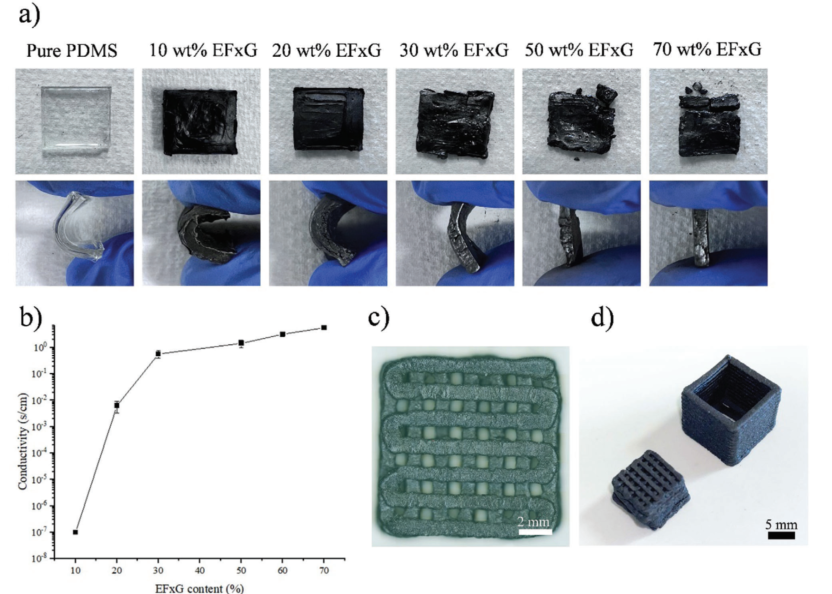0_3D-printed PDMS/Graphene sensors with tunable sensitivity
🚀 3D-Printed PDMS/Graphene Sensors with Tunable Sensitivity

🗓 Published on: Dec. 2024
📚 Journal/Conference: Advanced Electron Materials
🔍 Abstract
This study introduces PDMS/Graphene composites with high graphene content, formulated into printing ink for the fabrication of tunable multilayer pressure sensors via 3D printing. These sensors enable customizable conductivity, layer thickness, and sensor dimensions, paving the way for advanced applications in flexible electronics.
❓ Research Gap
Flexible pressure sensors have seen significant advancements, particularly through material optimization and innovative 3D printing techniques. However:
- ⚡ Most studies focus on low graphene content composites.
- 🔧 Few have explored tunable sensors with adjustable properties like conductivity and layer structure.
- 🚫 A need remains for high graphene content composites for enhanced functionality.
💡 Key Insights
🌟 Edge Functionalized Expanded Graphene (EFXG)
EFXG, derived from expanded graphite, exhibits:
- ✅ High solvent dispersibility (100 mg/ml).
- 🔬 Excellent potential for enhancing composite properties in 3D printing applications.
⚙️ Methods
🛠 Problem
Incorporating graphene into Sylgard 184 (a PDMS material) during simultaneous mixing of all components led to poor crosslinking when graphene content exceeded 5 wt.%.
🧪 Solution
A two-step process was developed:
- 🔄 Mixing and Pre-Crosslinking: Combine Sylgard 184 prepolymer and initiator, then heat at 60°C for 1 hour to initiate crosslinking.
- ➕ Graphene Addition: Introduce graphene post-initiation to reduce its hindering effect on the crosslinking process.
📊 Results
- 📏 Printability Limitation: Graphene content exceeding 12% caused unprintable viscosity levels.
- ⚡ High Conductivity: Composites with 60% graphene achieved superior electrical performance.
🎨 Questions for myself
What is Fourier Transform Infrared (FTIR) and Raman Spectroscopy used for?
- FTIR: A technique used to identify organic, polymeric, and some inorganic materials by measuring how different wavelengths of infrared light are absorbed by the material, providing information about molecular bonds and functional groups.
- Raman Spectroscopy: Complements FTIR by measuring inelastic scattering of light to identify vibrational modes of molecules, providing insights into molecular structures, crystallinity, and chemical composition.
What is Newtonian behavior?
- Newtonian Behavior: Refers to fluids whose viscosity remains constant regardless of the applied shear rate or stress. Examples include water and most simple oils.
What is the relationship between viscosity and shear rate?
- For Newtonian fluids, viscosity is constant and independent of shear rate.
- For non-Newtonian fluids, viscosity changes with shear rate:
- Shear-thinning (pseudoplastic): Viscosity decreases as shear rate increases (e.g., ketchup).
- Shear-thickening (dilatant): Viscosity increases as shear rate increases (e.g., cornstarch in water).
What is viscoelasticity? What is loss modulus and storage modulus?
- Viscoelasticity: A material property where the substance exhibits both viscous (fluid-like) and elastic (solid-like) behavior under deformation.
- Loss Modulus (G’’): Represents the energy dissipated as heat (viscous component).
- Storage Modulus (G’): Represents the energy stored and recovered per cycle (elastic component).
What is the recovery behavior of printing ink under stress? Is it necessary to test all the above properties?
- Recovery Behavior: Refers to the ability of ink to regain its original structure after stress is removed, crucial for maintaining print quality during and after extrusion. Testing recovery behavior helps evaluate print fidelity.
- Testing all properties depends on the application requirements. For high-precision applications, it’s often necessary to test rheological and viscoelastic properties.
What microscopy and morphology tests have they done?
- Common techniques include Scanning Electron Microscopy (SEM) for surface topography and structural details, and Atomic Force Microscopy (AFM) for nanoscale surface characterization. Additional tests may involve Optical Microscopy and Transmission Electron Microscopy (TEM) for detailed internal morphology.
What is gauge factor?
- Gauge Factor (GF): The ratio of relative change in electrical resistance to the mechanical strain applied to a material. It’s a key parameter for evaluating the sensitivity of strain sensors.
🗣 Discussion
The temperature-induced crosslinking approach effectively addresses challenges posed by high graphene content. This study demonstrates how tailored 3D-printed composites can unlock new possibilities in flexible pressure sensor design.
🌟 Personal Insights
This paper inspired me to think about the balance between material composition and manufacturing techniques. It aligns closely with my research interests in sensor innovation and flexible electronics, providing a foundation for future exploration.
📖 References
Chen, Chong‐You, et al. “3D‐Printed PDMS/Graphene Sensors with Tunable Sensitivity via Temperature‐Induced Crosslinking for Pressure Applications.” Advanced Electronic Materials (2024): 2400653, doi: 10.1002/aelm.202400653
0_3D-printed PDMS/Graphene sensors with tunable sensitivity



